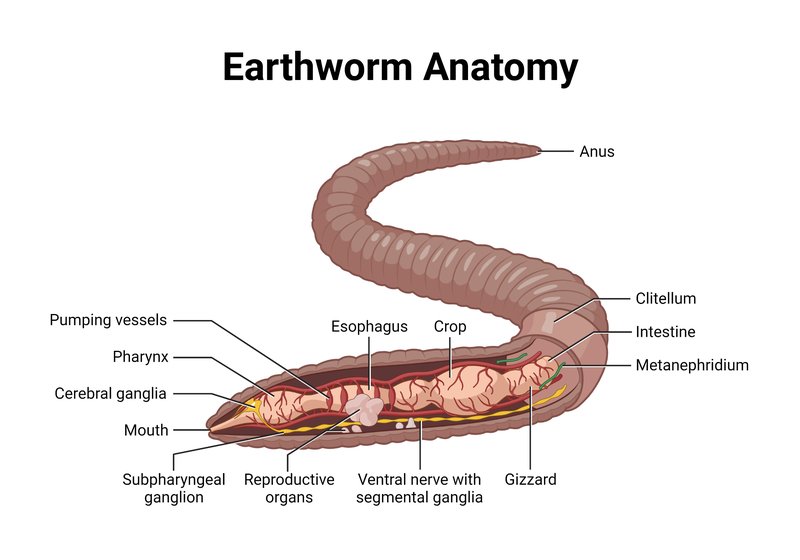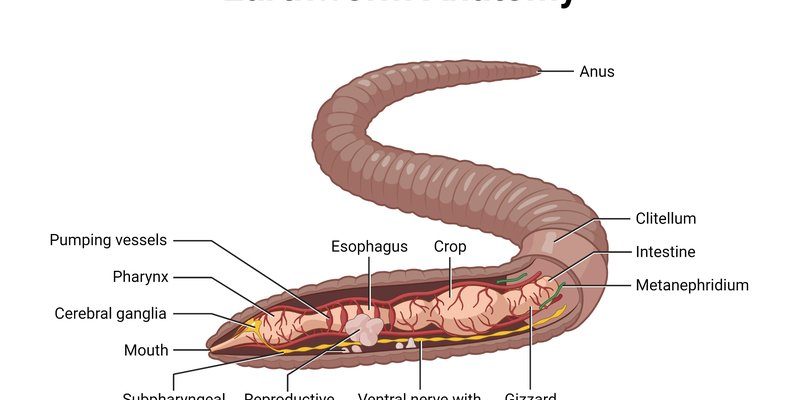
Understanding how these parts work together can give you a new appreciation for these unsung heroes of the ecosystem. So settle in with your favorite drink, and let’s explore the inner workings of earthworms in a way that’s as simple as pie—just like peeling back the layers of an onion.
What Are Earthworm Segments?
Earthworms have a unique body structure that’s divided into many segments. Think of their body as a train made up of several cars, each one connected yet distinct. Each of these segments plays a key role in how the worm moves and functions. Most earthworms have between 100 and 150 segments, and this is not just for show!
Each segment contains muscles that allow the worm to stretch and contract. This movement is what helps them burrow through the soil. When an earthworm wants to move forward, it contracts the muscles in the front segments while relaxing the muscles in the back. It’s like a wave moving through its body, pushing it along the earth.
The segments also house vital organs, including parts of the digestive and reproductive systems. For example, the clitellum, a thickened band of segments, plays a key role in reproduction, helping in the creation of cocoons for the worms’ eggs. So, every segment has a purpose—making earthworms fascinating little organisms that are masters of their underground world.
Understanding Setae: The Earthworm’s Tiny Helpers
Now, let’s talk about setae—the tiny bristles that line the earthworm’s body. You might be thinking, “Bristles? What’s the big deal about those?” Well, these setae are essential for the worm’s movement and traction. Imagine trying to walk on a slippery floor without any grip—pretty tricky, right? That’s what setae help earthworms avoid when they’re wriggling through soil.
Setae are made of a hard, chitinous material that helps earthworms anchor themselves as they push through the earth. When it wants to move forward, it anchors the setae in the back segments into the soil, creating a stable base. This allows the front segments to stretch out and move forward.
Not only do setae help with movement, but they also offer some stability in soft soil. If you’ve ever tried running on sand, you’ll understand how important it is to have something to grip onto! Without these little bristles, earthworms would struggle to navigate their habitat, making them less effective at aerating our gardens and enriching the soil.
The Role of the Gizzard in Digestion
Next up is the gizzard, which is part of the earthworm’s digestive system. If you think of your stomach as a blender that breaks down food, you can think of the gizzard as an even tougher version. Located after the crop, the gizzard is a muscular organ that grinds up the organic material that earthworms consume.
Earthworms primarily eat decaying leaves, plants, and other organic matter they find in the soil. Once the food enters the gizzard, it’s mixed with grit and then crushed into smaller pieces. This grinding process is vital because it helps break down the food so that the nutrients can be absorbed in the intestines later on.
What’s fascinating is that earthworms actually ingest small stones and dirt to assist with this grinding action. Talk about eco-friendly! By using what’s already around them, they effectively turn organic matter into nutrient-rich soil as they pass through the digestive tract.
How Earthworm Anatomy Affects Their Role in the Ecosystem
Now you might be wondering why this anatomy matters at all. Well, earthworms play a crucial role in maintaining healthy soil ecosystems. Their segmented bodies and setae allow them to aerate the soil, which is vital for plant health. When they burrow, they create pathways that let air and water penetrate deeper into the earth, supporting plant roots.
Moreover, as they break down organic matter with their gizzards, earthworms recycle nutrients, turning dead plant material into rich humus. This process enriches the soil, making it more fertile for plants to grow. Without the proper anatomy to support these functions, earthworms wouldn’t be able to contribute as significantly to ecosystems.
In a way, they’re like tiny gardeners, constantly improving the soil. If you’ve ever enjoyed a flourishing garden, you can thank earthworms for their hard work!
Comparing Earthworm Anatomy to Other Worms
It’s natural to compare earthworms to other types of worms you might stumble upon. For instance, take a look at leech anatomy. While they also have segmented bodies, leeches don’t have setae. Instead, they have suckers that help them latch onto their hosts. This difference highlights how specific adaptations suit different lifestyles and environments.
Another example is the roundworm. Unlike earthworms, roundworms have a complete digestive system and a more rigid body structure. This allows them to thrive in various environments, including freshwater and even parasitic habitats. They may not have the same ecological role as earthworms, but they put their unique anatomy to work in their own niche.
By understanding these differences, you can appreciate the diversity of worm species and how their anatomy reflects their roles in the ecosystem.
Why Learning About Earthworm Anatomy Matters
So, why should you care about earthworm anatomy? Understanding how these little creatures work can deepen your appreciation for the natural world. They may be small, but their contribution to soil health and the environment is mighty. By knowing how earthworms function, you can make better choices in gardening, composting, and even landscaping.
For instance, if you’re eager to create a thriving garden, consider how many earthworms are in your soil. A healthy earthworm population can improve the soil structure, helping plants absorb nutrients and water more effectively. You might even think about starting a worm compost bin, which harnesses their natural skills to turn kitchen scraps into nutrient-rich compost.
Ultimately, recognizing the importance of these tiny creatures can inspire you to protect their habitats, whether it’s by reducing pesticide use or creating more organic gardens.
In conclusion, earthworm anatomy is a masterclass in nature’s design. With their segments, setae, and gizzards, they do so much more than just wiggle in the dirt. By learning about them, you open the door to a world that’s rich with life and interconnectedness, reminding us that even the smallest beings can have a big impact. So next time you see an earthworm, take a moment to appreciate its remarkable journey beneath your feet!

